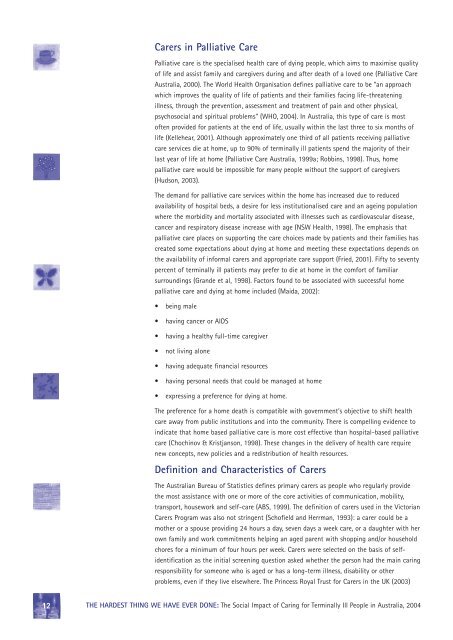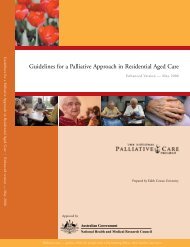The hardest thing we have ever done - Palliative Care Australia
The hardest thing we have ever done - Palliative Care Australia
The hardest thing we have ever done - Palliative Care Australia
Create successful ePaper yourself
Turn your PDF publications into a flip-book with our unique Google optimized e-Paper software.
<strong>Care</strong>rs in <strong>Palliative</strong> <strong>Care</strong><br />
<strong>Palliative</strong> care is the specialised health care of dying people, which aims to maximise quality<br />
of life and assist family and caregivers during and after death of a loved one (<strong>Palliative</strong> <strong>Care</strong><br />
<strong>Australia</strong>, 2000). <strong>The</strong> World Health Organisation defines palliative care to be “an approach<br />
which improves the quality of life of patients and their families facing life-threatening<br />
illness, through the prevention, assessment and treatment of pain and other physical,<br />
psychosocial and spiritual problems” (WHO, 2004). In <strong>Australia</strong>, this type of care is most<br />
often provided for patients at the end of life, usually within the last three to six months of<br />
life (Kellehear, 2001). Although approximately one third of all patients receiving palliative<br />
care services die at home, up to 90% of terminally ill patients spend the majority of their<br />
last year of life at home (<strong>Palliative</strong> <strong>Care</strong> <strong>Australia</strong>, 1999a; Robbins, 1998). Thus, home<br />
palliative care would be impossible for many people without the support of caregivers<br />
(Hudson, 2003).<br />
<strong>The</strong> demand for palliative care services within the home has increased due to reduced<br />
availability of hospital beds, a desire for less institutionalised care and an ageing population<br />
where the morbidity and mortality associated with illnesses such as cardiovascular disease,<br />
cancer and respiratory disease increase with age (NSW Health, 1998). <strong>The</strong> emphasis that<br />
palliative care places on supporting the care choices made by patients and their families has<br />
created some expectations about dying at home and meeting these expectations depends on<br />
the availability of informal carers and appropriate care support (Fried, 2001). Fifty to seventy<br />
percent of terminally ill patients may prefer to die at home in the comfort of familiar<br />
surroundings (Grande et al, 1998). Factors found to be associated with successful home<br />
palliative care and dying at home included (Maida, 2002):<br />
• being male<br />
• having cancer or AIDS<br />
• having a healthy full-time caregiver<br />
• not living alone<br />
• having adequate financial resources<br />
• having personal needs that could be managed at home<br />
• expressing a preference for dying at home.<br />
<strong>The</strong> preference for a home death is compatible with government’s objective to shift health<br />
care away from public institutions and into the community. <strong>The</strong>re is compelling evidence to<br />
indicate that home based palliative care is more cost effective than hospital-based palliative<br />
care (Chochinov & Kristjanson, 1998). <strong>The</strong>se changes in the delivery of health care require<br />
new concepts, new policies and a redistribution of health resources.<br />
Definition and Characteristics of <strong>Care</strong>rs<br />
<strong>The</strong> <strong>Australia</strong>n Bureau of Statistics defines primary carers as people who regularly provide<br />
the most assistance with one or more of the core activities of communication, mobility,<br />
transport, housework and self-care (ABS, 1999). <strong>The</strong> definition of carers used in the Victorian<br />
<strong>Care</strong>rs Program was also not stringent (Schofield and Herrman, 1993): a carer could be a<br />
mother or a spouse providing 24 hours a day, seven days a <strong>we</strong>ek care, or a daughter with her<br />
own family and work commitments helping an aged parent with shopping and/or household<br />
chores for a minimum of four hours per <strong>we</strong>ek. <strong>Care</strong>rs <strong>we</strong>re selected on the basis of selfidentification<br />
as the initial screening question asked whether the person had the main caring<br />
responsibility for someone who is aged or has a long-term illness, disability or other<br />
problems, even if they live elsewhere. <strong>The</strong> Princess Royal Trust for <strong>Care</strong>rs in the UK (2003)<br />
12 THE HARDEST THING WE HAVE EVER DONE: <strong>The</strong> Social Impact of Caring for Terminally Ill People in <strong>Australia</strong>, 2004
















